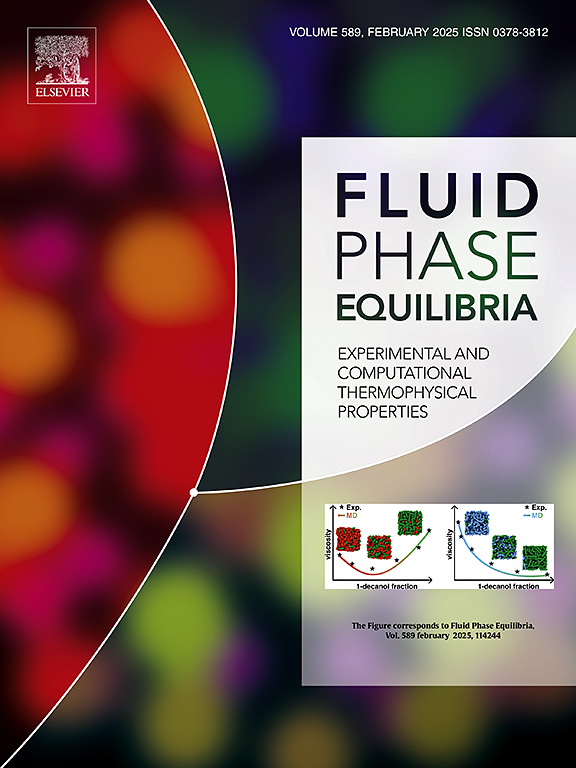Thermodiffusion of CO2 mixtures in the extended critical region
IF 2.7
3区 工程技术
Q3 CHEMISTRY, PHYSICAL
引用次数: 0
Abstract
Thermodiffusion, also known as Soret effect, stands for the mass flux driven by a temperature gradient, leading to partial component separation in fluid mixtures. While typically small in magnitude and often neglected, thermodiffusion can become significant under specific conditions, such as in the extended critical region. In this work, the thermodiffusion behavior of diluted supercritical mixtures of carbon dioxide with methane, ethane, or isobutane is investigated with molecular simulation techniques. Thermodiffusion is studied along the isobar over a temperature range from to 345 K, where singular thermodynamic and transport properties are observed. Attention is given to the crossover region near the critical point, where asymptotic power laws no longer apply, but long-range fluctuations still influence fluid behavior. Within this region, characterized by the Widom line, extreme values for the thermodiffusion and Soret coefficients are predicted. The underlying mechanisms responsible for this behavior are explored, and it is shown to be primarily driven by the extrema of the partial molar enthalpy of the solvent in the extended critical region.

CO2混合物在扩展临界区域的热扩散
热扩散,也被称为索雷特效应,是指由温度梯度驱动的质量通量,导致流体混合物中部分成分分离。虽然通常很小,经常被忽视,但热扩散在特定条件下可能变得重要,例如在扩展的临界区域。在这项工作中,用分子模拟技术研究了稀释的超临界二氧化碳与甲烷、乙烷或异丁烷混合物的热扩散行为。在T=290至345 K的温度范围内,沿着9MPa等压线研究了热扩散,观察到奇异的热力学和输运性质。注意在临界点附近的交叉区域,在那里渐近幂律不再适用,但长期波动仍然影响流体行为。在这一区域内,以智慧线为特征,预测了热扩散系数和索雷特系数的极值。对这种行为的潜在机制进行了探索,并表明它主要是由溶剂在扩展临界区域的偏摩尔焓的极值驱动的。
本文章由计算机程序翻译,如有差异,请以英文原文为准。
求助全文
约1分钟内获得全文
求助全文
来源期刊

Fluid Phase Equilibria
工程技术-工程:化工
CiteScore
5.30
自引率
15.40%
发文量
223
审稿时长
53 days
期刊介绍:
Fluid Phase Equilibria publishes high-quality papers dealing with experimental, theoretical, and applied research related to equilibrium and transport properties of fluids, solids, and interfaces. Subjects of interest include physical/phase and chemical equilibria; equilibrium and nonequilibrium thermophysical properties; fundamental thermodynamic relations; and stability. The systems central to the journal include pure substances and mixtures of organic and inorganic materials, including polymers, biochemicals, and surfactants with sufficient characterization of composition and purity for the results to be reproduced. Alloys are of interest only when thermodynamic studies are included, purely material studies will not be considered. In all cases, authors are expected to provide physical or chemical interpretations of the results.
Experimental research can include measurements under all conditions of temperature, pressure, and composition, including critical and supercritical. Measurements are to be associated with systems and conditions of fundamental or applied interest, and may not be only a collection of routine data, such as physical property or solubility measurements at limited pressures and temperatures close to ambient, or surfactant studies focussed strictly on micellisation or micelle structure. Papers reporting common data must be accompanied by new physical insights and/or contemporary or new theory or techniques.
 求助内容:
求助内容: 应助结果提醒方式:
应助结果提醒方式:


